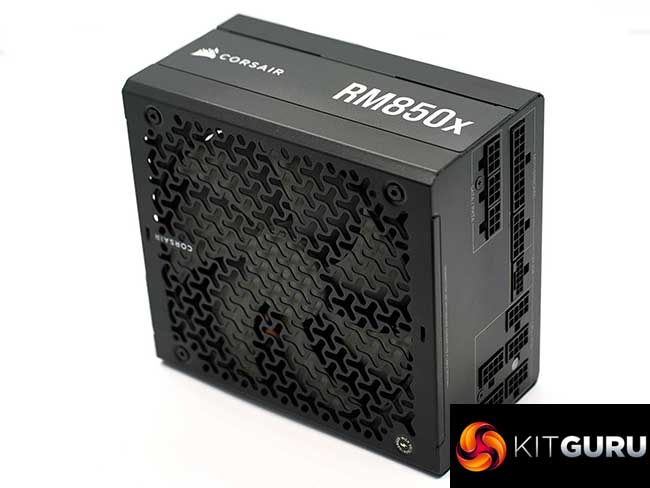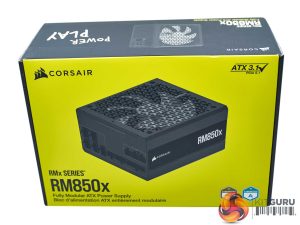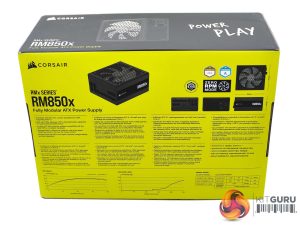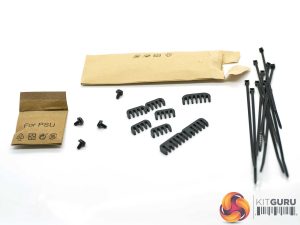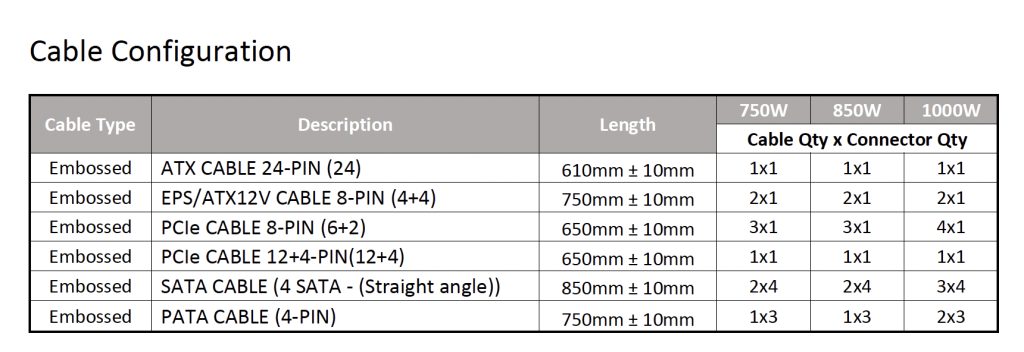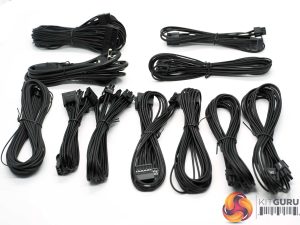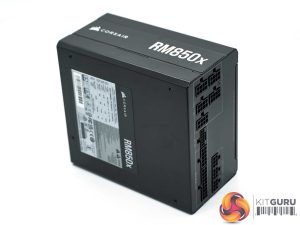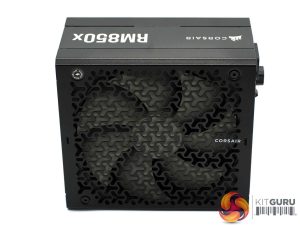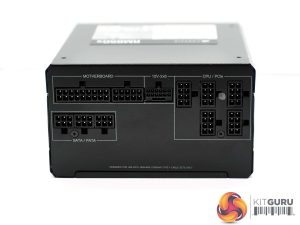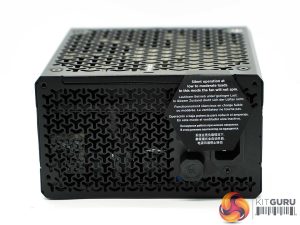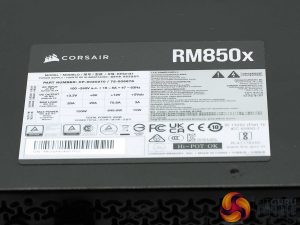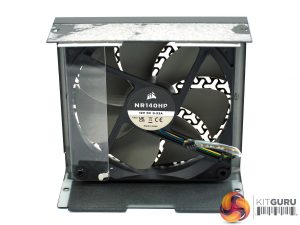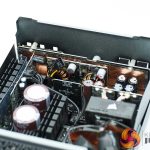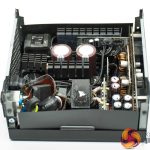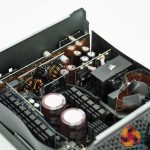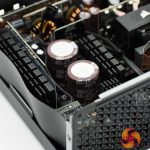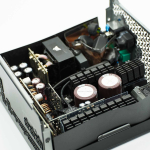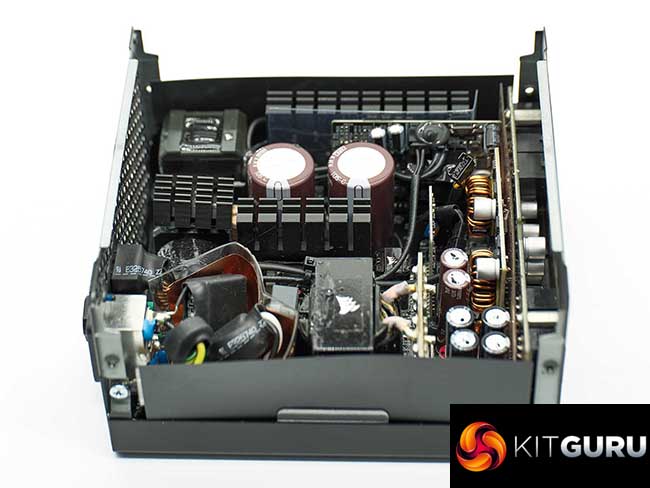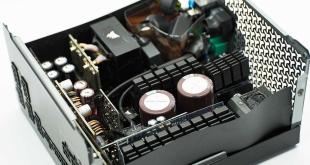
See the RM1000x review HERE .
Today we take a look at the first in a new range of power supplies that we received recently from Corsair. The RMx series has received an update from Corsair to meet the latest ATX 3.1 standard. It also boasts a new fan control knob, allowing the user to adjust fan speed under light loads, from zero RPM to full speed. This unit is fully modular and adopts all Japanese capacitors with a low noise fluid dynamic bearing fan. Corsair supports this range with a 10 year warranty.
Key features:
- Fully Modular PSU: Reliable and efficient low-noise power supply with fully modular cabling, so you only have to connect the cables your system build needs.
- Intel® ATX 3.1 Certified: Compliant with the ATX 3.1 power standard, supporting the PCIe Gen 5 platform and resisting transient power spikes.
- Native 12V-2×6 Connector: Ensures compatibility with the latest graphics cards with a direct GPU to PSU connection – no adapter necessary.
- 100% Japanese Capacitors: Delivers steady, reliable power and dependable electrical performance with 105°C-rated Japanese capacitors.
- Low Noise with 140mm Fan: A 140mm FDB fan with a specially calculated fan curve ensures low-noise operation even at full load, with a fan speed adjustment knob on the back for quick manual control.
- Six-Layer PCB: A modular PCB with 50% more layers provides improved voltage stability and heat dissipation.
- 50oC Maximum Operating Temperature: For reliable power even under high-stress conditions.
- Modern Standby Compatible: Extremely fast wake-from-sleep times and better low-load efficiency.
- Cybenetics Gold-Certified: Steady power output at up to 90% efficiency, less noise, and cooler temperatures.
- Zero RPM Fan Mode: For near-silent operation at lower loads.
- Resonant LLC Topology with DC-to-DC Conversion: Provides clean, consistent power and enables use of more energy-efficient sleep states.
- Ten-Year Warranty: Your guarantee of reliable operation for peace of mind through multiple builds.
We all immediately recognise this artwork – it's a pretty well established colour scheme by now – with bright yellow colours, a high resolution image of the unit, along with some details at the bottom.
The rear of the box shows some details on the power supply, including the 10 year warranty and some fan and efficiency graphs at the bottom. Corsair focus now on the Cybernetics badges more than 80 Plus, which makes a lot more sense to me.
The power supply is shipped between two cardboard protective sides. The accessories and cables are in a separate section inside the main box. Corsair include some cable ties, combs, and mounting screws in the box.
The cable quality is really very good and a step above the last units I tested. They include two EPS and three PCIe 6+2 pin connectors – all on separate cables, which is good to see. There are no in-cable capacitors on any of the cables.
The Corsair RM850x measures 150 mm x 85 mm x 160 mm (WxHxD) and it weighs around 1.8KG. These dimensions will suit any ATX chassis.
The fan is protected behind a rather fancy looking grille, offering a lot of airflow capabilities. The 140mm unit is marked as a high grade fluid dynamic bearing model. We will take a closer look at this shortly when we open the unit.
The modular bay is split into three sections as shown in the image above. These are all clearly labelled for ease of installation.
The other side of the power supply is home to the power connector, switch and a fan control knob. This allows the end user to tweak the fan speeds under moderate loads, and you can even disable it completely at low loads.
The RM850x delivers 20A to both secondary +3.3V and +5V rails. The +12v primary rail can output 70.8A.
Corsair are using the NR140HP fan inside this power supply. It is a 140mm unit and rated 12V DC 0.33A. This is a high grade fluid dynamic bearing fan that is quiet at lower speeds.
This power supply is produced for Corsair by Channel Well Technology (CWT). This has been a long, and quite fruitful relationship between the two companies. This unit is a modern design implementation – half bridge topology with an APFC converter and an LLC resonant converter on the primary side. The secondary side adopts a synchronous rectification system for the 12V rail and a pair of DC-DC converters for the minor rails.
We can see that the design adopts large heatsinks to help keep temperatures under control. All of the capacitors on the primary and secondary side are high quality Japanese and the two primary capacitors are 105c rated, Nippon Chemi Con, from their KMW series. They are rated 400V 470uF for a total of 940uF.
Soldering quality is high across the PCB.
Correctly testing power supplies is a complex procedure and KitGuru have configured a test bench which can deliver up to a 2,000 Watt DC load. We run at 35c in our environment to greater reflect warmer internal chassis conditions.
We use combinations of the following hardware:
• SunMoon SM-268
• CSI3710A Programmable DC load (+3.3V and +5V outputs)
• CSI3711A Programmable DC load (+12V1, +12V2, +12V3, and +12V4)
• Extech Power Analyzer
• Extech MultiMaster MM570 digital multimeter
• Extech digital sound level meter
• Digital oscilloscope (20M S/s with 12 Bit ADC)
• Variable Autotransformer, 1.4 KVA
We test in a single +12V configuration.
|
DC Output Load Regulation
|
||||||||||
|
Combined DC Load |
+3.3V
|
+5V
|
+12V
|
+5VSB
|
-12V | |||||
|
A
|
V
|
A
|
V
|
A
|
V
|
A
|
V
|
A | V | |
|
85W
|
0.95
|
3.33
|
0.92
|
5.01
|
6.00
|
12.01
|
0.50
|
5.00
|
0.20 | -12.00 |
|
170W
|
1.70
|
3.33
|
1.67
|
5.01
|
12.35
|
12.01
|
1.00
|
5.01
|
0.20 | -12.01 |
|
425W
|
3.00
|
3.33
|
3.05
|
5.01
|
32.20
|
12.00
|
1.50
|
5.00
|
0.30 | -12.01 |
| 640W | 4.05 | 3.33 | 4.05 | 5.01 | 49.00 | 11.99 | 2.00 | 5.00 | 0.30 | -12.00 |
|
850W
|
5.00
|
3.33
|
5.23
|
5.01
|
65.52
|
11.98
|
2.50
|
5.00
|
0.50 | -12.01 |
Load regulation is really good on all the rails.
Next we want to try Cross Loading . This basically means loads which are not balanced. If a PC for instance needs 500W on the +12V outputs but something like 30W via the combined 3.3V and +5V outputs then the voltage regulation can fluctuate badly.
| Cross Load Testing | +3.3V | +5V | +12V | -12V | +5VSB | |||||
| A | V | A | V | A | V | A | V | A | V | |
| 760W | 1.0 | 3.33 | 1.0 | 5.01 | 60.0 | 11.99 | 0.2 | -12.02 | 0.50 | 5.01 |
| 165W | 15.0 | 3.32 | 18.0 | 5.01 | 2.0 | 12.01 | 0.2 | -12.01 | 0.50 | 5.01 |
The power supply dealt with the demanding cross load test without any major concerns.
We then used an oscilloscope to measure AC ripple and noise present on the DC outputs. We set the oscilloscope time base to check for AC ripple at both high and low ends of the spectrum.
ATX12V V2.2 specification for DC output ripple and noise is defined in the ATX 12V power supply design guide.
|
ATX12V Ver 2.2 Noise/Ripple Tolerance
|
|
|
Output
|
Ripple (mV p-p)
|
|
+3.3V
|
50
|
|
+5V
|
50
|
|
+12V1
|
120
|
|
+12V2
|
120
|
|
-12V
|
120
|
|
+5VSB
|
50
|
Obviously when measuring AC noise and ripple on the DC outputs the cleaner (less recorded) means we have a better end result. We measured this AC signal amplitude to see how closely the unit complied with the ATX standard.
| AC Ripple (mV p-p) | ||||
| DC Load | +3.3V | +5V | +12V | 5VSB |
| 100W | 8 | 10 | 10 | 10 |
| 225W | 11 | 12 | 12 | 11 |
| 450W | 12 | 13 | 15 | 13 |
| 675W | 13 | 14 | 18 | 14 |
| 850W | 17 | 16 | 23 | 15 |
Noise suppression is exceptional across +3.3V, +5V rails. The +12V rail results are superb as well.
|
Efficiency (%) 240V
|
|
|
100W
|
89.5
|
|
225W
|
91.5
|
|
450W
|
92.0
|
|
675W
|
91.3
|
| 850W | 89.4 |
The efficiency results are really good, peaking at around 92% between 45-55% load, and dropping to around 89.4% at full load. A good set of results.
We take the issue of noise very seriously at KitGuru and this is why we have built a special home brew system as a reference point when we test noise levels of various components. Why do this? Well this means we can eliminate secondary noise pollution in the test room and concentrate on components we are testing. It also brings us slightly closer to industry standards, such as DIN 45635.
Today to test the power supply we have taken it into our acoustics room environment and have set our Digital Sound Level Noise Decibel Meter Style 2 one meter away from the unit. We have no other fans running so we can effectively measure just the noise from the unit itself.
As this can be a little confusing for people, here are various dBa ratings in with real world situations to help describe the various levels.
KitGuru noise guide
10dBA
– Normal Breathing/Rustling Leaves
20-25dBA
– Whisper
30dBA
– High Quality Computer fan
40dBA
– A Bubbling Brook, or a Refrigerator
50dBA
– Normal Conversation
60dBA
– Laughter
70dBA
– Vacuum Cleaner or Hairdryer
80dBA
– City Traffic or a Garbage Disposal
90dBA
– Motorcycle or Lawnmower
100dBA
– MP3 Player at maximum output
110dBA
– Orchestra
120dBA
– Front row rock concert/Jet Engine
130dBA
– Threshold of Pain
140dBA
– Military Jet takeoff/Gunshot (close range)
160dBA
– Instant Perforation of eardrum
|
Noise (dBA)
|
|
|
100W
|
<28
|
|
225W
|
<28
|
|
450W
|
32.1
|
|
675W
|
34.7
|
| 850W | 37.8 |
The fan is quiet at slower speeds before spinning up at 600 Watts to compensate for rising temperatures inside the chassis. At full load it's clearly audible.
|
Temperature (c)
|
||
|
Intake
|
Exhaust
|
|
|
100W
|
37
|
41
|
|
225W
|
38
|
44
|
|
450W
|
40
|
52
|
|
675W
|
45
|
57
|
|
850W
|
46
|
60
|
Temperatures inside the chassis remain solid even at higher load levels.
This new Corsair RM850x has proven to be a very capable power supply in our testing over the previous week. The build quality is high and the use of a fluid dynamic bearing fan with control knob ensures the end user can tune the noise levels until high power levels are demanded. In the real world, this power supply is reasonably quiet at loads most people will be seeing (500-600 Watts full draw).
The long term partnership with CWT has been fruitful for Corsair. This power supply is very well put together, with quality 105C-rated capacitors from Japanese brand Nippon Chemi Con used in the primary stage, a good indication that corners have not been cut. Soldering quality is also high, and the placement of several large heatsinks ensures the main PCB has adequate cooling across a wide range of demanding situations. This is a very good platform that deserves a lot of praise.
I like the quality of the cables supplied with this power supply and, being a modular design, you only need to attach the cables you really need for whatever build you are working on.
Technically, the unit is very solid. Ripple suppression is very tight and falls well within industry rated parameters and load regulation also proves a good selling point across all the rails. Efficiency is good for a Gold rated supply and it is always pleasing to see Corsair putting value in the Cybenetics system, I just wish more manufacturers would drop the dated 80 Plus standards to focus on this much more modern, capable certification platform.
The pricing of this unit has been moving a little over the last week, but using the Corsair webpage, we can see they are selling it directly for £147.99 inc. VAT HERE . This is not a budget power supply, but it is worth the money as it delivers quality power.
It is worth pointing out that there are previous versions of the RM850x power supply still being sold online, so make sure you get this latest version. Corsair are standing behind the RM850x with a 10 year warranty, for peace of mind.
Discuss on our Facebook page HERE .
Pros:
- ATX 3.1 and PCIe 5.1 ready.
- Cybenetics Gold Efficiency certification.
- Tight load regulation.
- Great ripple suppression.
- Low noise until higher loads.
- Fluid dynamic bearing fan.
- 10 year warranty.
- Fully modular.
- Control knob to adjust fan speed.
- Delivers the full 850 Watts.
Cons:
- It's quite expensive.
KitGuru says: The Corsair RM850x delivers quality power, the build quality and modular cabling are both excellent. Technically ripple suppression is very tight and the adoption of a quality fluid dynamic bearing fan, along with manual control, means you can tweak this supply to be as quiet as possible. We recommend this power supply without reservation for a new high end PC build.
 KitGuru KitGuru.net – Tech News | Hardware News | Hardware Reviews | IOS | Mobile | Gaming | Graphics Cards
KitGuru KitGuru.net – Tech News | Hardware News | Hardware Reviews | IOS | Mobile | Gaming | Graphics Cards


